
India, known for its spiritual serenity, is considered to be saturated with the essence of gods and goddesses, their enduring imprints, and an ever-present sense of divinity in the surrounding environment. The abodes of these deities, commonly known as temples, represent the magnificence of the ancient and culturally rich Hindu Sanatan Dharma. They are considered to be sacred places where devotees can connect with the divine and seek blessings from the deities. The architecture and design of temples in India vary widely depending on the region and the era in which they were built. Temples in India also serve as important centers of social and cultural activity. They are often the site of religious festivals and ceremonies, as well as community events like weddings and cultural performances. In many cases, the temple serves as the focal point of the community, bringing together people from all walks of life to celebrate and worship together. Overall, temples in India are a testament to the country’s rich spiritual and cultural heritage. They are not just places of worship, but also symbols of the enduring traditions and values that have shaped Indian society for millennia.
#1 Badrinath Temple
Badrinath, a significant place of pilgrimage, is regarded as the abode of the Nara Narayana sages, and Srimad Bhagavatam indicates that saintly people, such as Uddhava, have been visiting the place for thousands of years. It is one of the eight self-manifested holy tirthas of India. Badrinath, Rameshwaram, Jagannath Puri, and Dwarka represent the planets of the spiritual sky, consisting of the brahmajyoti and the Vaikuntha. Devotees visit all these holy places for spiritual perfection. Badrinath is particularly dear to Lord Krishna, and the name “Badrinath” comes from the Ilandai tree, which is beloved by Maha-Lakshmi.

According to Srimad Bhagavatam (3.4.22), “There in Badrikashram, the Personality of Godhead, in his incarnation as the sages Nara and Narayana, had been undergoing great penance since time immemorial for the welfare of all living entities.” Skanda Purana proclaims, “There are several sacred shrines in heaven, on earth, and in hell; but there is no shrine like Badrinath.” Badrinath is also known as “Narada Kshetram” because Narada Muni attained liberation here in just five days. Gautama Rishi, Kapila, and Kasyapa are said to have visited, and Sankaracharya established a temple here. Sankaracharya, Ramanujacharya, and Madhvacharya all visited Badrinath in the past.
The Badrinath temple can be found perched at an elevation of roughly 3415 meters above sea level in the Chamoli District of Uttarakhand. The temple sits within the serene valley of Garhwal Himalayas, nestled on the banks of the flowing Alaknanda river. The temple is dedicated to Lord Badrinath and the murti of the deity is self-manifested from a black shaligram-shila, which is 213m (2 ft) high. The temple is adorned with ancient stone carvings, and visitors must cross the Alakananda River and climb up steps to reach it. Lord Badrinath is depicted meditating in the padmasana, with Uddhava to his right, Nara and Narayana on the far right, Narada Muni kneeling in front of the right side, Kubera and a silver Ganesh on the left side, and Garuda kneeling in front to the left of Badrinarayana. The temple also has a separate shrine dedicated to Lakshmi Devi and the Gaddi of Adi Sankaracharya.
Story of Badrinath
The temple’s history, according to the Puranas, dates back to the four ages of creation – Satya-yuga, Treta-yuga, Dvapara-yuga, and Kali-yuga. The Lord lived in a visible form in Badarikashrama during Satya-yuga, and sages could see the Lord through the practice of yoga in Treta-yuga. However, in Dvapara-yuga, it became difficult for even the sages and demigods to see the Lord. In response to their prayers, the Lord instructed them to take a divine image of him from under Narada Shila in the Alaknanda and establish it in a temple. Brahma and other gods built the temple, and the deity was worshiped for six months by humans and six months by gods.
The Skanda Purana tells another story of the establishment of the temple. Lord Shankar prophesied that he would come in the form of a saint and install the deity of Sri Badrinath Ji for the good of all people in Kali-yuga. Shankaracharya fulfilled this prophecy by finding the deity in Narada Kund and installing it in the temple. The priests at the temple had replaced the four-armed form of Narayana with a shaligram-shila stone after the robbers had hidden the form of the Lord in the nearby kund. Shankaracharya went to the kund, found the deity of Lord Narayana, and installed it in the temple. However, the fingers on the right hand of the deity were broken. After pulling out two more deities with the same broken fingers, a voice told Shankaracharya that only this broken form would be worshiped in Kali-yuga.
Today, the temple of Lord Badrivishal attracts people of all races, creeds, religions, and communities who come to see the deity of Lord Narayana. The temple’s history and stories associated with it add to its significance, making it an important pilgrimage site in India.
#2 Kedarnath Temple
The Kedarnath Temple, dedicated to Lord Shiva, is situated on the bank of the Mandakini River between Gangotri and Badrinath. Located at a height of 3584 meters above sea level, Kedarnath is surrounded by awe-inspiring snow-clad peaks, earning its status as the most secluded site of all four Char Dham Shrines. The region has been historically referred to as “Kedar Khand”. The temple was originally built by the Pandavas to atone for sins accrued during the Kurukshetra war and was reconstructed by Shankaracharya in the 8th century. It is considered one of the major Shiva temples in India and one of the 12 Shiva-Jyotirlingas.
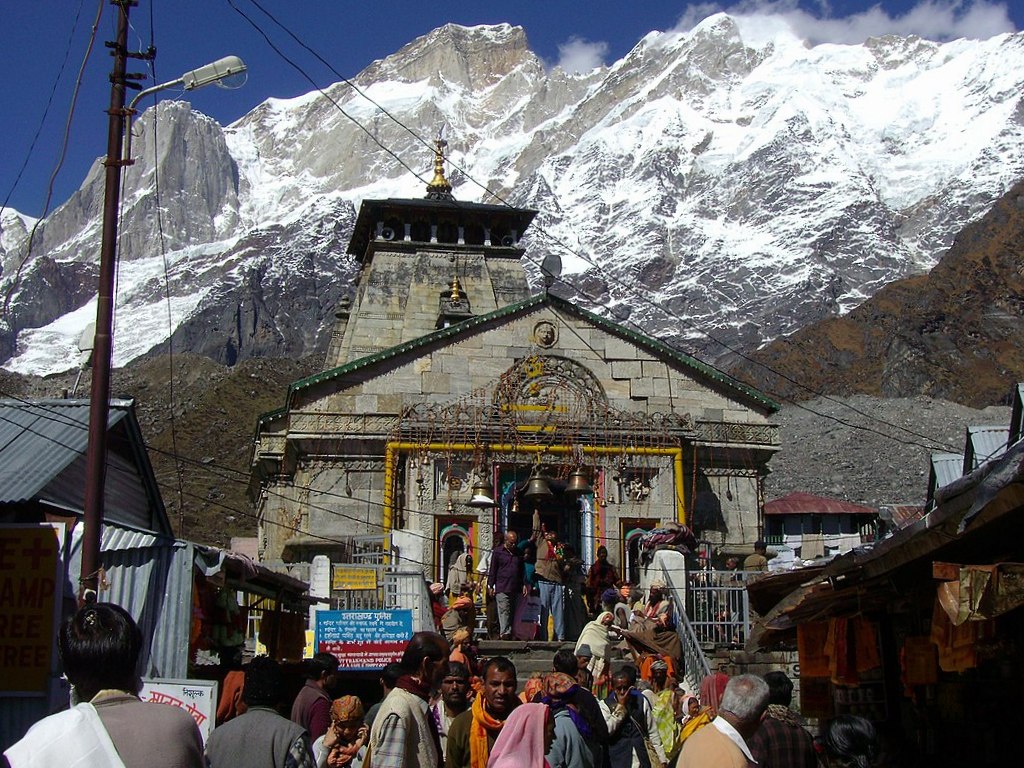
Over 100,000 pilgrims visit the temple each year. The temple features an irregular, three-faced linga representing the hump of Lord Shiva in the form of a bull. There are deities of goddess Parvati and Ganesh in front of the main altar door, and outside the second door are Lord Krishna, the five Pandavas, their wife, Draupadi, and their mother, Kunti. The temple faces south, which is a unique feature, and is situated at the end of a lane surrounded by small hotels and restaurants. The Kedarnath Temple is open to the public from the first week of May until either the last week of October or the first week of November. The busiest time of the year is during May and June. During the winter, worship is conducted in the village of Okhimath by the priest from the Kedarnath Temple.
Story of Kedarnath
After the Battle of Kurukshetra, the Pandavas sought Lord Shiva in Kasi to seek atonement for the sin of killing their kinsmen in battle. However, Lord Shiva playfully avoided them by disguising himself first as a brahmana in Gupta Kasi and then as a bull in a valley in the Himalayas. Bhima, one of the Pandavas, recognized Lord Shiva as the bull and caught him by the tail. Lord Shiva then decided to give them his audience and instructed the Pandavas to worship the hump of the bull, which led to the establishment of the Kedarnath temple. The Pandavas also built temples in other mountains where other parts of Lord Shiva’s body had appeared, known as PanchKedars: Kedarnath for the hump, Tungnath for the arm, Rudranath for the face, Kalpeshwar for the hair, and Madhyamaheshwar for the navel.
#3 Gangotri Temple
Here is the tale of how River Ganga descended from the heavens to the earth and became revered. Sagara was a wise king who had 60,000 brave and strong sons. He was the Emperor of the World and performed one hundred great sacrifices to be accepted as such. During his final sacrifice, he set a horse free to roam the world for a year. If other kings captured it, they would declare war against him. However, Indra, the king of the gods, stole the horse to prevent Sagara from taking over heaven. Sagara’s sons found the horse at Kapila’s ashram and, thinking he was the thief, attacked him, resulting in their death. Simply by looking at Sagara’s sons, Kapila Muni burnt them to ashes. Later, one of Sagara’s grandsons found the horse and took it back to his grandfather, who completed the one-hundredth sacrifice.

Many years later, Bhagiratha, Sagara’s great-grandson, asked Kapila how he could help his ancestors ascend to heaven. Kapila suggested that the River Ganga could purify their ashes. The water of the River Ganga is holy because Lord Vishnu’s toe cracked the wall of the universe, and some water entered, which became the River Ganga. In ancient times, Lord Vishnu had appeared as the Vamana avatar and with just three strides, he encompassed the entire universe. As he took his final step, his toe punctured the wall of the universe, causing water to gush in and form the River Ganga, which flowed in heaven. Since the water had touched Vishnu’s foot, it was considered sacred.
Following Bhagiratha’s prayers, Lord Vishnu asked the River Ganga to descend to earth, but she was too ferocious. Lord Shiva held out his matted hair to catch her as she fell, softening her descent to earth. The River Ganga flowed across India, and Bhagiratha led it. One of the streams washed the ashes of the dead princes (ancestors of Bhagiratha), and their souls went to heaven. The River Ganga still flows in India and is considered holy by Hindus. They bathe in her waters for purification and liberation. She is also known as Bhagirathi as Bhagiratha caused her descent to earth from the heavens.
Situated at an elevation of 3,100 meters, Gangotri Temple is the highest temple devoted to Goddess Ganga and is among the four sacred Chota Char Dham Yatra pilgrimage sites in Uttarakhand. Goddess Ganga is venerated as the embodiment of the revered Ganga River. The serene and pristine white temple is surrounded by Deodar and Pine trees and the magnificent Greater Himalayan Range. The holy Bhagirathi River, which is one of the two primary headstreams of Ganga, flows adjacent to the Gangotri Temple. The source of the River Ganga is located at the base of the Gangotri glacier, where it is known as ‘Bhagirathi’. Legend has it that the Gangotri Temple is approximately 200 years old. The temple was constructed in the 18th century by the Gorkha commander Amar Singh Thapa and was later reconstructed by the King of Jaipur. The temple’s Nagara style of architecture is made of white marble stone and features exquisite carvings, with five small pinnacles towering 20 feet high. The principal sanctum or Garbha Griha is erected on an elevated platform. The deities of Goddess Ganga, Yamuna, Annapurna, Saraswati, and Lakshmi are worshiped with great reverence. Additionally, the inner sanctum houses the deities of Bhagiratha and Adi Shankara. Near the Gangotri Temple lies a natural Shiva Linga that is submerged underwater. According to legends, Lord Shiva sat here and divided the Ganga River into seven streams to control her flow. The vicinity of Gangotri Temple includes ‘Bhagirath Sila,’ the spot where King Bhagirath prayed to Lord Shiva to bear the descent of the Ganges. This area holds great significance for devotees who collect water from here to take back to their homes. After the Mahabharata war, the Pandavas performed the ‘Deva Yagna’ at Gangotri to atone for the loss of their loved ones and people.
#4 Yamunotri Temple
Yamunotri is a site of the Char Dham pilgrimage and is located in Uttarkashi district at a height of 3293 mts above sea level. It offers peace and tranquility to visitors and is surrounded by mountains on all sides. The Bandarpunch Mountain lies north of Yamunotri. It is located at a distance of 236 km from Rishikesh, 21 km from Sanya Chatti, 278 km from Dehradun, and 176 km from Chamba. The Uttarakhand Govt has approved the construction of a 3.3 km long ropeway between Kharsali and Yamunotri that will reduce the traveling time to 15 minutes and have a carrying capacity of 500 pilgrims per hour.
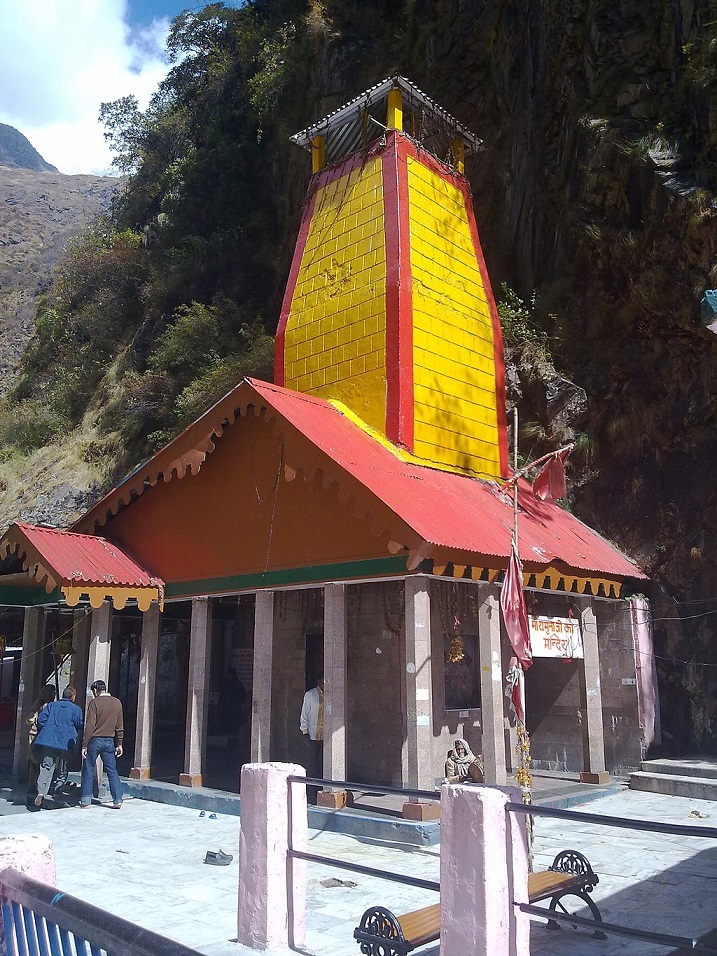
Saptarishi Kund, the glacial lake that is the actual source of the Yamuna, is situated at an even higher altitude of 4,421 meters, and can be reached only after a challenging trek to the base of Kalinda Parvat, requiring a guide and a day of acclimatization at Yamunotri. The climb to Saptarishi Kund involves traversing snow and ice. Along the way, visitors pass by the confluence of the Yamuna and Nil Ganga, known as Shani Prayag, where a temple dedicated to Lord Shani is located. The Yamuna River flows from west to east at Yamunotri.
The Yamunotri temple, built in 1839, honors the goddess Yamuna who was born from the union of Surya and Sangya. Yamuna’s black stone statue is housed in the temple alongside the white statue of Gangadevi. Legend has it that bathing in Yamuna’s waters can prevent a painful death. To pay respects to Yamuna, visitors are expected to first visit the Divya Shila located adjacent to the temple. According to the story, Yamuna was born from Surya and Sangya. Sangya would close her eyes when the bright Sun approached her, which angered Surya. As a result, he cursed her that her son would cause fear and take the lives of living beings. This son would be called Yamaraj. However, after seeing Sangya’s repentance, Surya blessed her that she would bear a daughter named Yamuna (also known as Kalindi) who would not only free people from the fear of Yamaraj but also release them from the cycle of birth and death. The temple is located at the foot of Kalinda Parvata and operates from late April to early November.
The true source of the Yamuna, is located at the challenging-to-reach Saptarishi Kund, which requires a guide to navigate. According to legend, the seven great rishis performed rigorous penance here for millions of years in Satya-yuga. To get to Saptrishi Kund, one must undertake a challenging trek spanning 7 kilometers from Yamunotri. This glacial lake measures half a kilometer in length and is encircled by rocky glaciers. Due to its arduous accessibility, very few people visit this remote location.
#5 Jagannath Temple of Puri
The Jagannath Puri temple, located in Eastern India, is regarded as one of India’s foremost spiritual destinations. The Supreme Lord Sri Vishnu is worshiped in the form of His deity (Lord Jagannath) in this temple, and visiting it is believed to have the same spiritual merit as visiting all other holy sites. The temple boasts impressive Oriya architecture with elaborate carvings adorning each of the four gates. The Mahaprasad served at the temple is a delectable treat that visitors should not pass up. The town’s lively religious festivals attract numerous tourists, with the Rath Yatra being the most highly anticipated. The temple’s spiritual significance, its mouth-watering cuisine, its peaceful ambiance, and the devotees’ passionate devotion make it a must-visit destination.
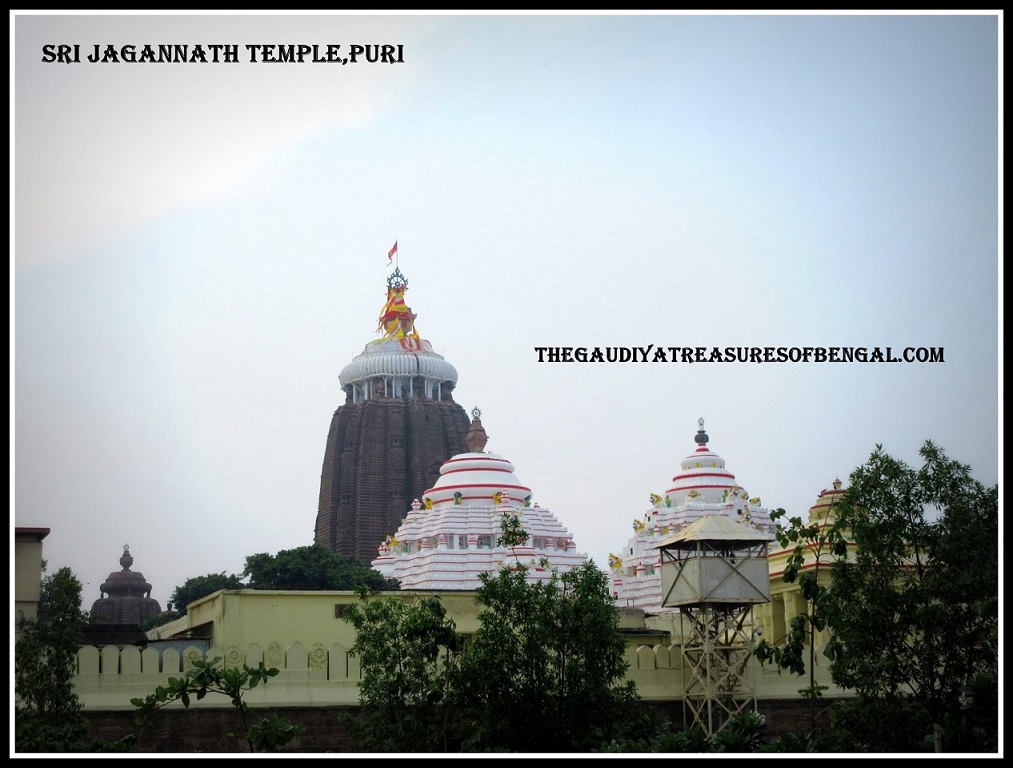
The history of the temple dates back to the time of Satya Yuga when King Indradyumna, a devout follower of Vishnu, consulted his priest for information on a sacred place where he could witness the Supreme Lord. The priest gathered a group of pilgrims who suggested Sri Purusottama Kshetra in Orissa, a location that boasted a temple dedicated to Lord Vishnu. The king dispatched his brother, Vidyapati, to obtain more information, who eventually found the site and described the ornate temple to the king. Narada Muni instructed King Indradyumna to construct a temple and install the deity of Lord Narasimha Deva along with deities of Bhu-devi and Lakshmidevi. The king performed one thousand Asvamedha yajnas and meditated upon the Supreme Lord, which led him to discover a divine tree from which the deities of Jagannath, Baladeva, and Subhadra would be carved.
#6 Lingaraja Temple, Bhubaneshwar, Orissa
Bhubaneshwar, the capital of Odisha, is renowned for its impressive temples. The Lingaraj Temple, dedicated to Lord Shiva, is the largest and most notable, built in the Odisha style of temple architecture. The temple has four distinct sections, each taller than the last and constructed with red sandstone walls. The Lingaraja temple complex also includes the Bhagawati temple and other shrines. The Linga, a Shiva emblem, is eight feet in diameter and bathed daily with milk, water, and bhang. Bhubaneshwar is also home to numerous temples surrounding the Bindusagar lake, and it is a popular destination for devotees who travel here from nearby Puri. According to beliefs, work on the temple began in the 6th century by Lalat Indu Keshari, and construction of the Assembly hall, sanctum, and temple tower began in the 11th century. The Hall of offering was built in the 12th century, while the Nata Mandira was built between 1099 and 1104 CE. The temple was completed in the last years of the 11th century, initiated by somvanshi king Yayati I, and renovated by Jajati Keshari, another king of the same dynasty. Thus, the history of the temple dates back to the 11th century, with earlier work dating to the 6th century.
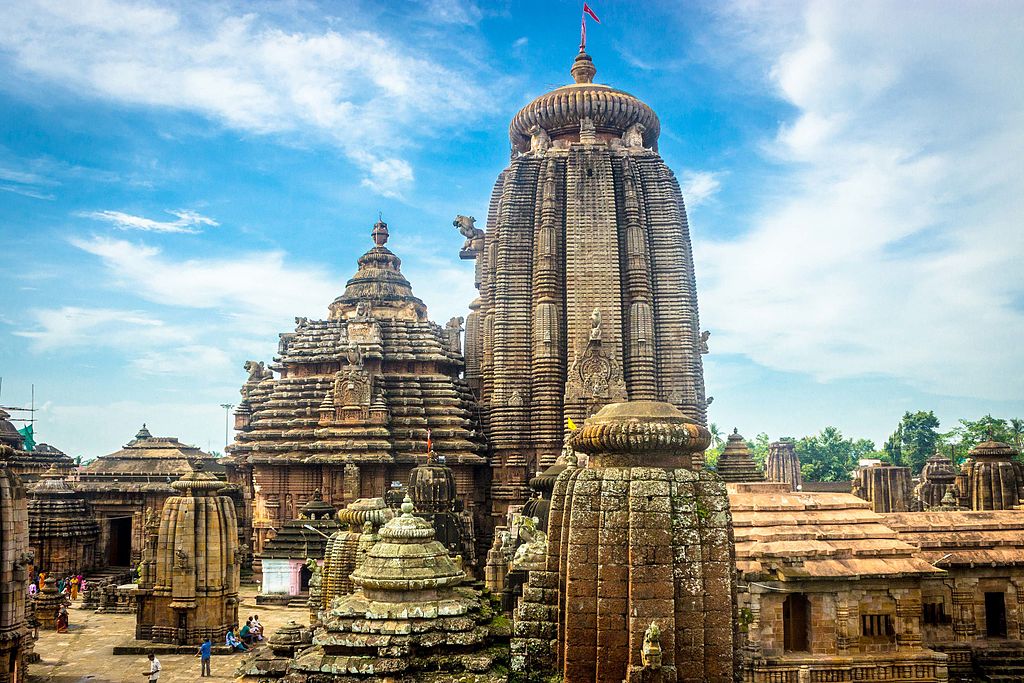
When Sri Chaitanya Mahaprabhu visited the Lingaraja temple 500 years ago, he glorified Lord Shiva as follows –
I offer my sincere respects and obeisances to you, the controller of the thirty primal demigods, the original father of all created beings, and the gracious one whose head is adorned with the crescent moon and from whose head arise the holy waters of Ganga. You are a festival for the eyes of the fair goddess Gauri.
I bow down to you, who shines like molten gold, dressed in radiant garments resembling fresh blue lotuses and rain clouds. You grant desirable boons to your devotees through your delightful dancing, and you are the Lord of the impersonalists whose flag bears the image of a bull.
My respects and obeisances are offered to you, who dispel darkness with your three eyes – the moon, sun, and fire. You generate auspiciousness for all living entities, and your potency easily surpasses that of thousands of moons and suns.
I offer my salutations to you, whose form is illuminated by the jewels of Ananta Deva and who is clothed in a tiger skin. You sit upon a lotus of a thousand petals and your two arms are adorned by radiant bangles.
My respects and obeisances are offered to you, who pour happiness upon your servitors by showering them with the nectar that flows from your lotus feet. You are embellished with an abundance of gems, and I pray that you may endow me with pure love for Sri Hari.
O Sri Rama, Govinda, Mukunda, Sauri, Sri Krishna, Narayana, and Vasudeva! I offer my obeisances to you, Sri Shiva, who is the monarch of intoxicated bee-like devotees, destroying all grief.
I humbly offer my respectful obeisances to you, who are constantly sought after by Sri Narada and other sages. You grant favors to them quickly and bestow the happiness of devotion unto Lord Hari upon those who seek your boons. You are the spiritual master of everyone.
Lastly, hearing these eight-fold prayers to Shiva with love and rapt attention can quickly grant devotion unto Lord Hari, transcendental knowledge, realization of that knowledge, and unprecedented devotional potency.
#7 Iskcon Mayapur temple, West Bengal
The holy abode of Mayapur, located in West Bengal, India, is considered by the esoteric to be the very center of the spiritual world and the highest realm of transcendence. Those who are well-versed with the conclusions of the revealed scriptures hold this belief. Mayapur is the birthplace of Lord Chaitanya Mahaprabhu, who appeared in the world in 1486 AD and began manifesting His ecstatic pastimes, enchanting one and all with His unique movements and unparalleled expressions. He propagated the widespread chanting of ‘Hare Krishna Hare Krishna Krishna Krishna Hare Hare, Hare Rama Hare Rama Rama Rama Hare Hare’.
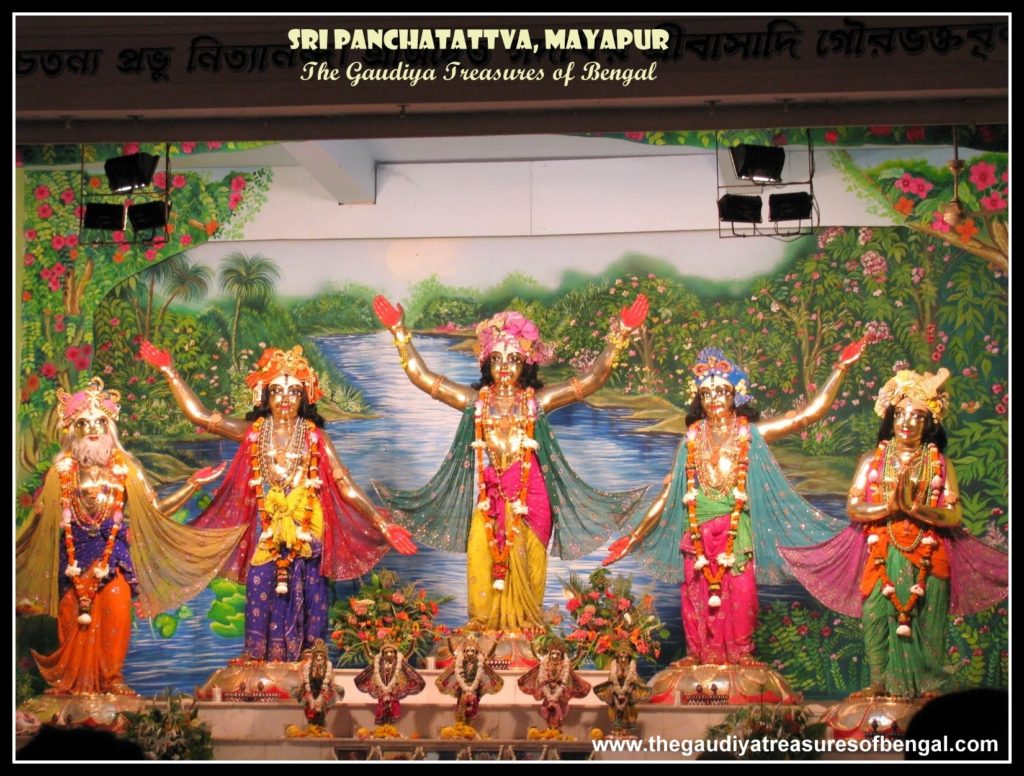 Srila Prabhupada, the founder acharya of ISKCON, named the headquarters of operations as ‘Sri Mayapur Chandrodaya Temple.’ He envisioned this temple to unleash a new age of awakening whereby the misguided souls of this dark iron age could get a second chance to reconnect with their eternal master, Sri Chaitanya. The Sri Mayapur Chandrodaya Temple project, which began in 1971, consists of a gigantic temple in its center surrounded by separate residential quarters. Srila Prabhupada visualized that this project would gradually grow to a population of fifty thousand in the days to come.
Srila Prabhupada, the founder acharya of ISKCON, named the headquarters of operations as ‘Sri Mayapur Chandrodaya Temple.’ He envisioned this temple to unleash a new age of awakening whereby the misguided souls of this dark iron age could get a second chance to reconnect with their eternal master, Sri Chaitanya. The Sri Mayapur Chandrodaya Temple project, which began in 1971, consists of a gigantic temple in its center surrounded by separate residential quarters. Srila Prabhupada visualized that this project would gradually grow to a population of fifty thousand in the days to come.
What to Experience at Iskcon Mayapur :
- Behold the captivating deities of Radha Madhava and the asta sakhis.
- Witness the enchanting deities of Pancha Tattva, including Lord Chaitanya and His associates.
- Experience the profound sight of Lord Narasimhadeva.
- Attend the joyful mangala Aratika darsana of the Lord at 4.30 am; it’s not to be missed!
- Pay respects at the samadhi of Srila Prabhupada and his disciples.
- Visit the goshala, where cows are cared for and worshiped.
- Marvel at the Temple of Vedic Planetarium, which is currently under construction.
- Don’t forget to treat yourself to the mouth-watering Krishna Prasadam.
- Yogpeeth, the birthplace of Chaitanya Mahaprabhu, is just a few meters away from Iskcon Mayapur. You can visit there to seek blessings.
- Take home a small book from one of the book stalls to help you further your Krishna consciousness.
#8 Kashi Vishwanath Temple, Varanasi
The Kashi Vishwanath temple, also known as the Golden Temple, is a well-known Hindu temple that honors Lord Shiva. The temple is located on the western bank of the holy river Ganges in Varanasi and is one of the twelve Jyotirlingas, the most sacred of Shiva’s temples. The temple has been destroyed and reconstructed numerous times throughout history, with the present structure being built by the Maratha monarch, Ahilya Bai Holkar of Indore in 1780. Since 1983, the government of Uttar Pradesh has been responsible for managing the temple.
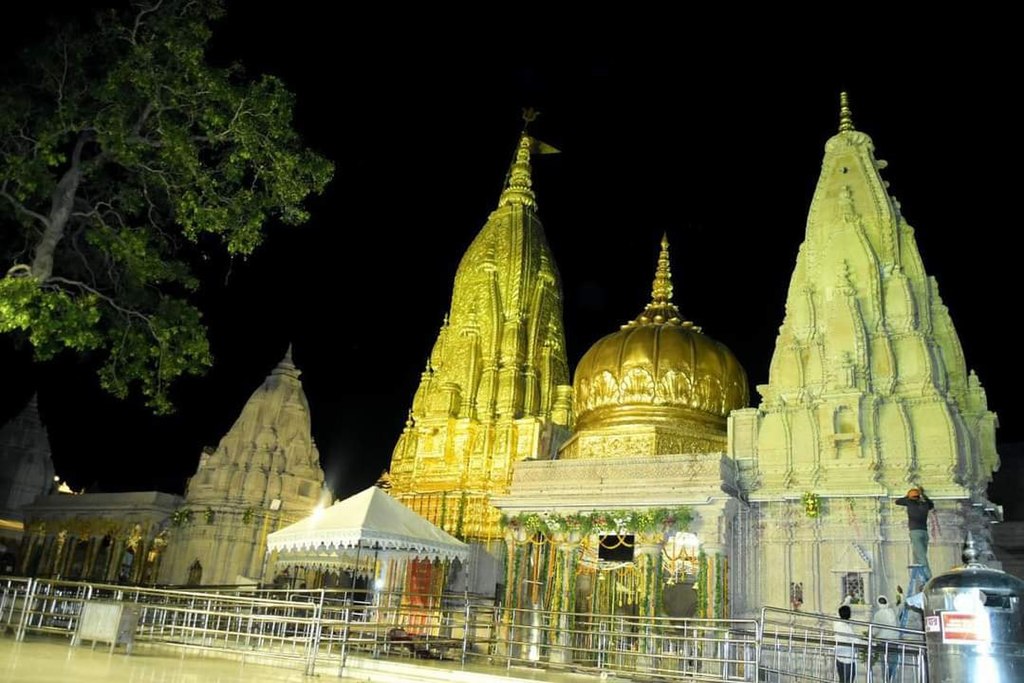
The primary deity of the temple is Vishwanatha or Vishweshwara, meaning Ruler of the universe. The temple draws visitors from all over India and the world and serves as a symbol of humanity’s desire to live in peace and harmony. During Shivratri, the Kashi Naresh, or King of Kashi, is the primary officiating priest, and no one else is allowed to enter the sanctum sanctorum until he has performed his religious duties. The temple is an essential part of India’s spiritual history, and it is believed that visiting Kashi Vishwanath temple provides the same benefits as visiting the scattered Jyotirlinga throughout India. Many great personalities, including Lord Chaitanya, Adi Shankaracharya, and Gurunanak, have visited the temple.
In 1839, two of the temple’s domes were coated in gold donated by Punjab Kesari Maharaja Ranjeet Singh. The Uttar Pradesh Ministry of Cultures & Religious Affairs also expressed a keen interest in covering the third dome in gold. A mere glimpse of the Jyotirlinga is said to be a cleansing experience for the soul, transforming life and leading one towards knowledge and bhakti.
During the year 2021, under the leadership of Prime Minister Sri Narendra Modi, the Kashi Vishwanath temple in India underwent a remarkable transformation. Previously a congested area with narrow lanes, the temple complex now spans over 5 lakh square feet, featuring a sprawling corridor. This world-class infrastructure allows for 60,000 devotees to have a smooth darshan every day, a feat that was once unimaginable. Despite facing numerous challenges, the temple complex and the wide corridor connecting it to Mother Ganga have been rejuvenated within a short period.
#9 Krishna Janmbhoomi (Janmasthan) Temple, Mathura
The Krishna Janmbhoomi temple in Mathura is an important pilgrimage site, built around the prison cell where Lord Krishna was born 5,000 years ago. The temple has been demolished and rebuilt several times over the centuries, with the present group of temples being the result of a major renovation project in the 20th century. The temple compound comprises the impressive Keshava Deva temple with the ‘garbha griha’ (sanctum sanctorum) and the Bhagavata Bhavan, which houses five shrines, including the main shrine of Sri Radha and Krishna, and an Ayurveda Bhavan, an international guest house, shops, a library, and an open space for performance.
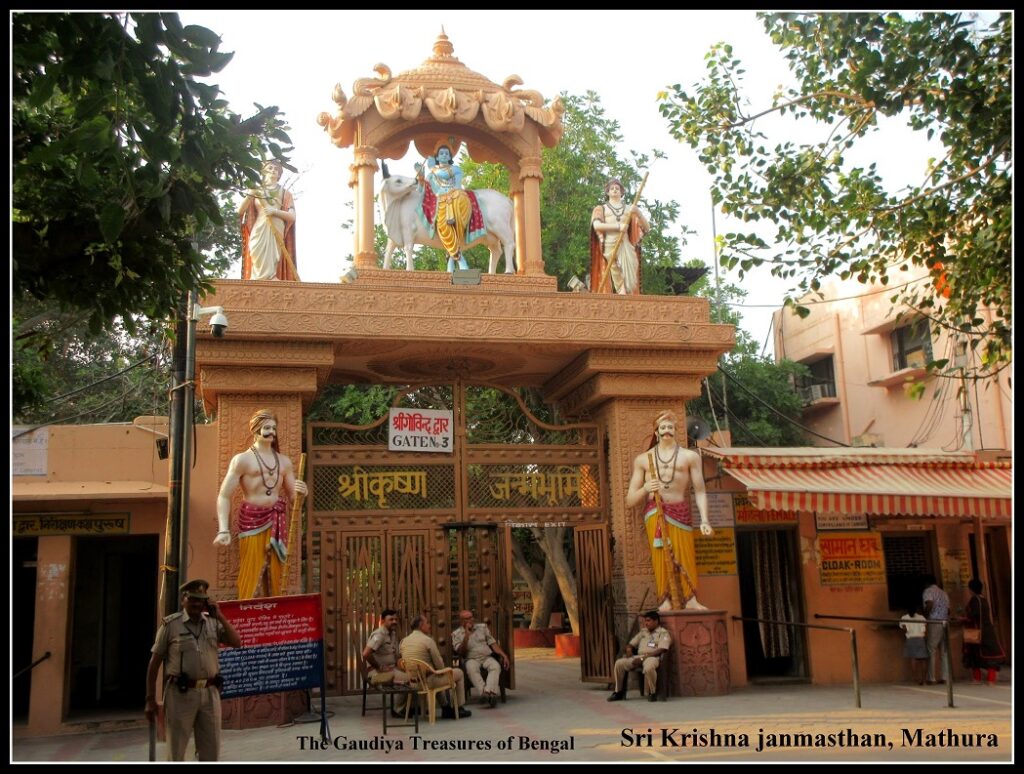
Sri Keshava Deva temple was built in memory of Jadiadeva Dalmia by Ramakrishna Dalmia and was inaugurated in 1958. The ‘garbha griha’ has the appearance of a prison cell, and a marble pavilion and an underground prison cell were built on the site, where Lord Krishna was accepted to have been born. The temple also has a large, deep water tank known as Potra Kunda, where Krishna’s baby clothes were washed by Devaki, which is believed to cleanse one of sins. The Skanda Purana says that one who, while chanting Japa and fasting, reaches the birthplace of Krishna is absolved from all their sins, while the Padma Purana says that those who once enter Krishna’s birthplace during the month of Kartik are successful in attaining supreme, indestructible Krishna.
#10 Barsana Radharani Mandir
The Radha Rani Mandir, also known as the Sriji temple or Ladli Mahal, is situated on top of a hill in Barsana, a village located 41 kilometers northwest of Mathura. Barsana is famous for being the place where Radha and Krishna manifested their eternal pastimes. The temple houses captivating deities of Radha and Krishna and is considered a significant holy site of Vraja Mandala. The hill on which the temple is built is called Brahmagiri, and it is said to be a manifestation of Lord Brahma, who had performed severe austerities to witness the pastimes of Radha and Krishna. The temple itself is characterized by tall walls, arches, pillars, and red sandstones and is embellished with intricate hand carvings, domes, balconies, and exquisite paintings of Radha Krishna’s pastimes on its inner walls and ceilings.

The present temple is said to have been built by King Veer Singh in 1675 AD, and one needs to climb a flight of about 200 stairs to reach the entrance of the main temple. The deities of Radha and Krishna are said to have been originally established at Barsana 5000 years ago by King Vajranabh, the great-grandson of Lord Krishna, but were lost in course of time. They were later recovered by Narayana Bhatta Goswami, a devotee in the line of Gadadhara Pandita, who had discovered several lost sites of Vraja Mandala and even established the standard path of Vraja Mandala parikrama as had been walked by Chaitanya Mahaprabhu.
Barsana Radha Rani Mandir is a significant pilgrimage site for devotees of Radha and Krishna and attracts thousands of visitors every year. The temple is not only a testimony to the rich cultural heritage of India but also serves as a reminder of the eternal love between Radha and Krishna, which continues to inspire devotees to this day.
#11 Dwarkadhish temple, Gujarat
The Dwarkadhish temple, also known as Jagat Mandir, is a holy site for Lord Krishna’s devotees located in Dwarka city, Gujarat. Dwarka, situated on the western tip of the Kathiawar Peninsula, is considered one of the holiest sites in India and is part of the Char Dhams pilgrimage, which includes Badrinath, Puri, and Rameshwaram. The temple was destroyed by Mahmud Begada in 1472 and rebuilt in the 15th-16th century. The temple has two entrances, Swarg Dwar and Moksha Dwar. The temple stands on the banks of the Gomti River, is five stories high, supported by 72 pillars, and has two entrances. To reach Swarg Dwar, one must climb 56 steps. Dwarka was the capital city of Lord Krishna, who was the prince of Dwarka and is worshiped here with great opulence. The black stone idol of Lord Krishna is located inside the temple, dressed ornately and adorned with symbols in his four silver-covered hands. During worship, Brahmanas beat drums and blow conch shells. Many small shrines are located within the sixteenth-century Dwarkadhish temple compound, including those of Lakshmi, Shiva, Radhika, Balarama, Pradyumna, Aniruddha, Jambavati, Satyabhama, and Purusottama Visnu. Facing the Dwarkadhish temple is the shrine of Devaki, Lord Krishna’s mother.
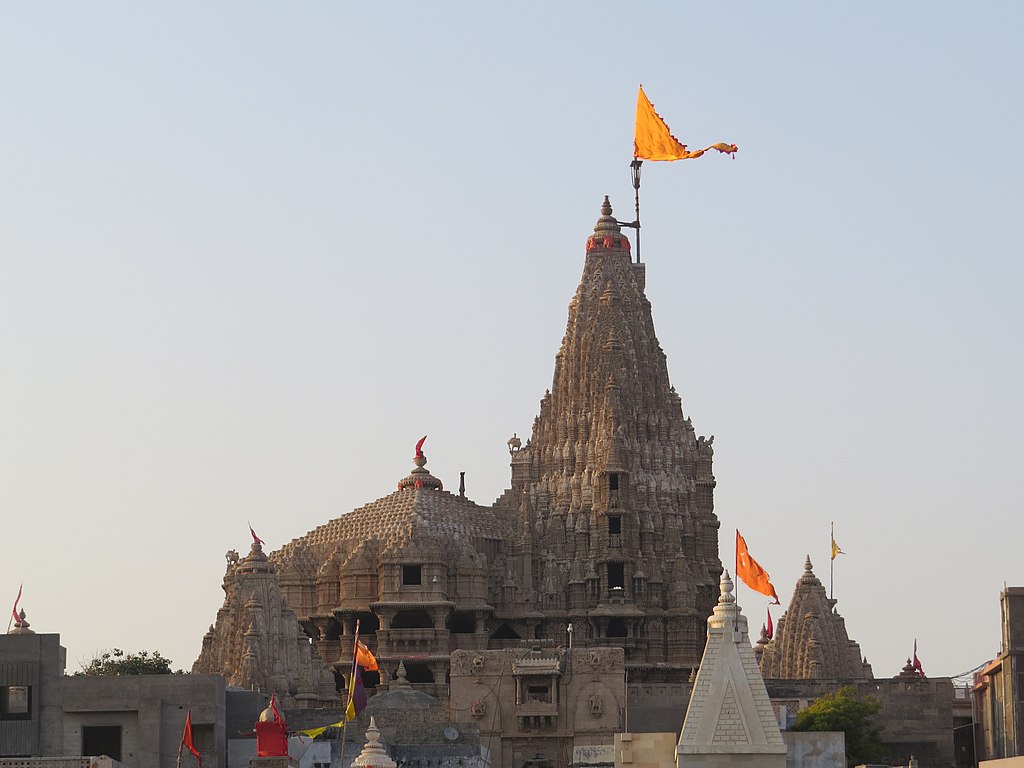
The Dwarkadhish temple is the main attraction for tourists visiting Dwarka and is believed to have been established more than 2,500 years ago by Lord Krishna’s great-grandson, Vajranabh. The temple has undergone several renovations, with imprints from the 16th and 19th centuries. The temple’s heavily sculptured walls are adorned with legends, and its impressive spire stands at 43 meters high. The temple has two doors for entry and exit, and a bridge called Sudama Setu leads to the beach across the Gomti Creek.
The Bhagavata Purana provides a description of the city of Dwarka during the time that Krishna resided there –
The city of Dwarka was filled with the sounds of birds and bees flying around parks and pleasure gardens, while its lakes were crowded with blooming lotuses and the calls of swans and cranes. The city boasted 900,000 royal palaces made of crystal and silver and decorated with huge emeralds and gold and jewels inside. The traffic flowed smoothly on a well-laid-out system of boulevards, roads, intersections, and marketplaces. Many assembly houses and temples of demigods graced the city. The residential area of Lord Hari, gorgeously decorated by the sixteen thousand palaces of Lord Krishna’s queens, was a beautiful private quarter worshiped by the planetary rulers. Narada Muni entered one of these immense palaces with coral pillars decoratively inlaid with vaidurya gems, sapphire walls, and perpetual brilliance floors. The palace was adorned with canopies, seats, and beds fashioned of ivory and precious jewels. Well-dressed maidservants bearing lockets on their necks and armor-clad guards with jeweled earrings attended to the palace. Numerous jewel-studded lamps dispelled all darkness, and peacocks danced on the ornate ridges of the roof. The fragrant aguru incense escaping through the holes of the latticed windows mistook for a cloud.
#12 Radha Govinda dev temple, Jaipur
The temple of Sri Govindaji has a rich and fascinating history that spans over five thousand years. According to legend, the temple was originally established by Lord Krishna’s great-grandson, Vajranaba. The Deity of Govindaji was one of several important Deities that were installed by Vajranaba in Vrindavan. However, over time, the temple and the Deity were lost to history.
In the 16th century, Srila Rupa Goswami was instructed by Sri Caitanya Mahaprabhu to excavate all of the lost holy places of Vrindavan, including the temple of Govindaji. Rupa Goswami searched tirelessly for the lost temple, but to no avail. Feeling despondent, he sat by the bank of the Yamuna river and began to call out the name of Lord Chaitanya.
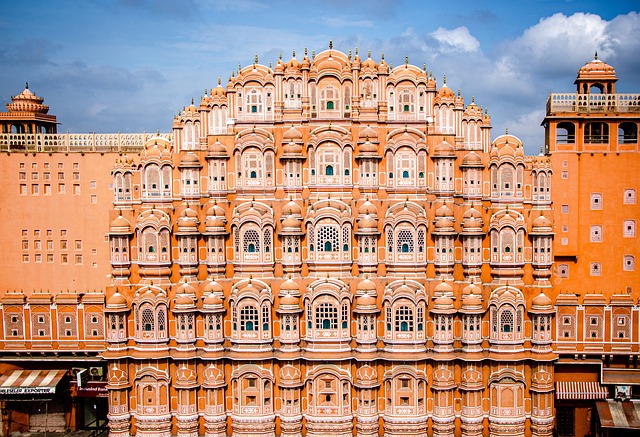
Suddenly, Lord Krishna appeared in the form of a beautiful brijbasi boy and led Rupa Goswami to a nearby hill where a cow emptied its milk into a hole on the hilltop. Rupa Goswami fell unconscious upon seeing the Deity of Govindaji within the hole. The temple of Radha Govinda was constructed under the guidance of Raghunatha Bhatta Gosvami and his disciples headed by Raja Man Singh of Jaipur in the late 16th century.
The temple was originally located in Vrindavan and was later moved to Amber, near Jaipur, by Maharaja Jai Singh II to protect the Deity from destruction at the hands of the Mughal emperor Aurangzeb. The temple was eventually moved to its present location in Jaipur in 1728.
Maharaja Jai Singh II created the city of Jaipur as a dedication to Lord Govindaji, and the temple is located within the innermost walls of the old city, right next to the city palace. The temple is set in a garden within the palace complex, and the full-sized Deities of Govindaji and Radha Rani can be found on the altar.
The temple of Sri Govindaji is not just a place of worship but also a symbol of the rich and vibrant history of India. Its intricate architecture, stunning artwork, and fascinating legends attract thousands of visitors every year, making it a must-see destination for anyone interested in the culture and history of India.
#13 Ramanathaswamy Temple, Rameshwaram, Tamil Nadu
Rameshwaram is a sacred place located on an island shaped like a conch shell, 160 km southeast of Madurai, India. It is considered one of the holiest pilgrimage places in India and is highly respected by all. Rameshwaram is one of the four holy dhams, along with Badrinath, Jagannath Puri, and Dwarkadhish temple of Gujarat. The island is 55 km by 12 km and is revered by worshippers of both Shiva and Rama.
According to Srimad-Bhagavatam, Lord Balarama visited “Setubandha (Rameshwaram)” during his pilgrimage, and Lord Chaitanya also visited Rameshwaram during his South India tour. Rameshwaram is best known for the Sri Ramanathaswamy Temple, which is one of the most venerated temples in India.
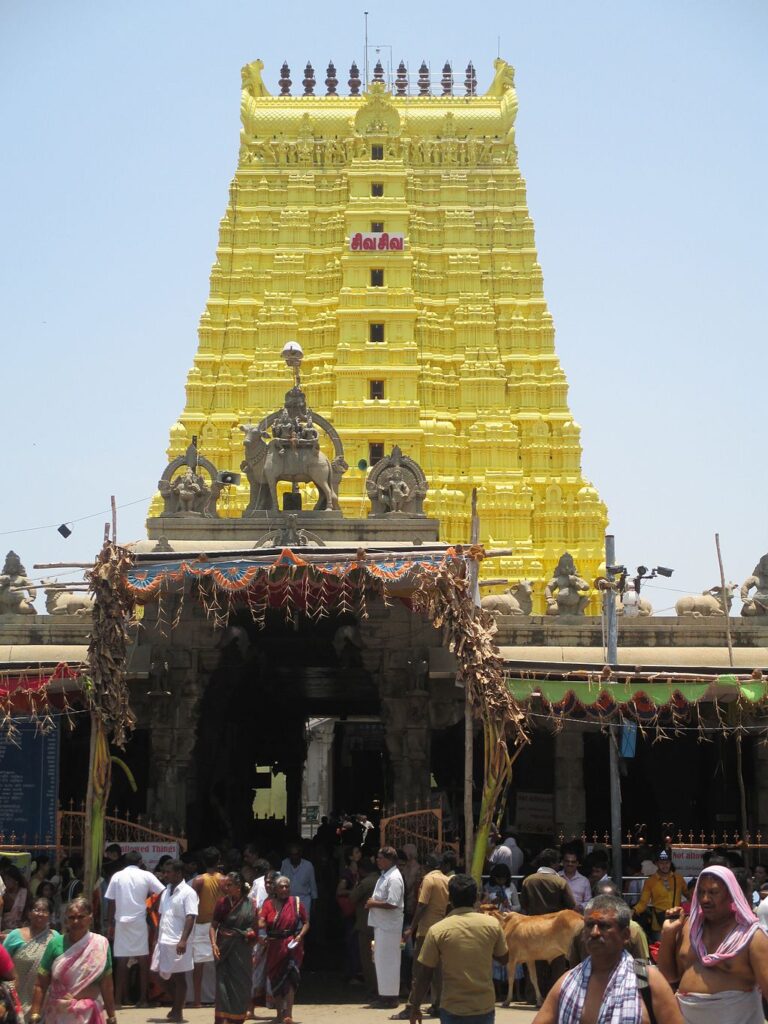
The temple was started by Lord Rama, who, after his victory in the battle of Lanka, wanted to absolve himself of the sin of vanquishing Ravana by installing a Shiva-linga at Rameshwaram. It is said that Lord Rama Himself installed the Siva-lingam at this place, lending added importance to this holy place. He tasked Hanuman with flying to Kailash to retrieve a Shivalinga while Goddess Sita crafted a small lingam in the meantime. The lingam made by Goddess Sita is known as Ramalingam, while the one brought by Lord Hanuman is called Vishwalingam. To this day, it is customary to worship the Vishwalingam first, as instructed by Lord Rama, before the Ramalingam.
The temple complex includes a stunning 3,700 feet long corridor, the longest in India, which goes around the temple and has elaborately designed and carved large sculptured pillars. Lord Rama also constructed a floating bridge of stones on the Indian Ocean with the help of the monkey army to rescue his wife Sita, who was held captive at Lanka.
The island has historical and religious significance, and the Sri Ramanathaswamy Temple is one of the most venerated temples in India. Visitors can explore the temple complex and witness the beautiful 3,700 feet long corridor with its elaborately designed and carved large sculptured pillars. Rameshwaram is a must-visit destination for anyone interested in history, culture, and spirituality.
#14 Sri Ranganathaswamy Temple, Srirangam, Tamil Nadu
The city of Srirangam in Tamil Nadu is home to the Sri Ranganathaswamy Temple, the largest functioning temple globally, dedicated to Lord Vishnu in His reclining form as Ranganatha. According to Puranas and Vedic writings, the history of Sri Rangam dates back to the beginning of creation. Legend has it that Lord Vishnu appeared in the form of Ranganatha for Brahma to worship, and Brahma eventually passed on the worship to Vivasvan, the sun-god, and then to Svayambhuva Manu, the father of mankind.
Lord Ramachandra presented the Deity of Sri Ranganatha to Vibhishana, who was traveling to Sri Lanka with the Lord’s vimana. Vibhishana stopped near the Kaveri River, where King Dharma Varma had been praying to serve Lord Ranganatha. The Lord blessed King Dharma Varma by promising to stay at Sri Rangam, and the king and his successors in the Chola dynasty built a large temple around the vimana of Lord Ranganatha.
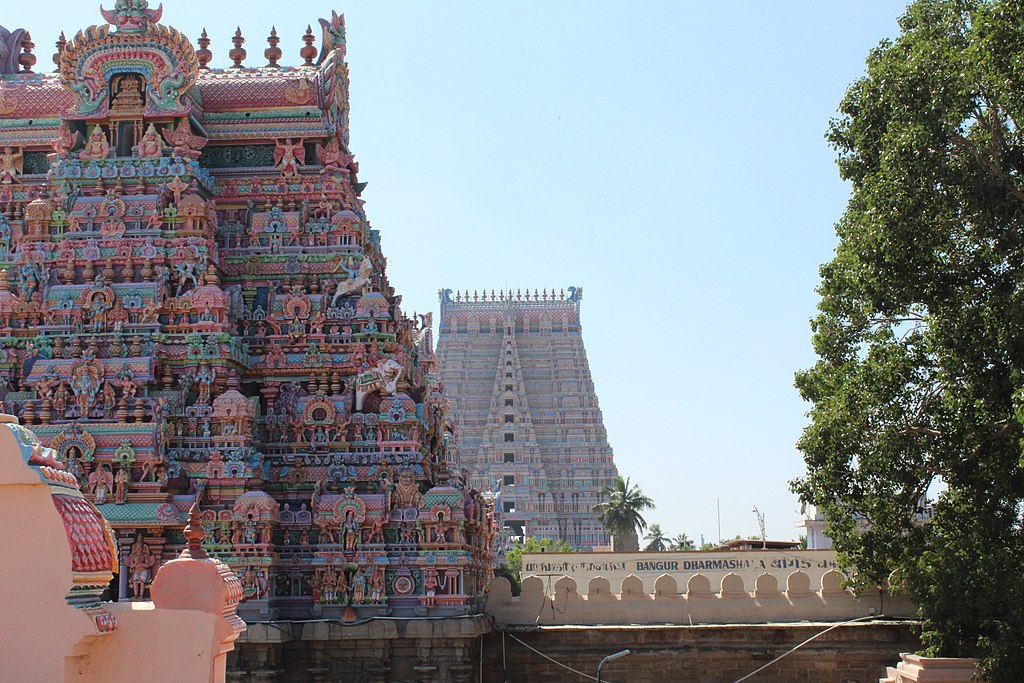
Over the years, the temple was expanded, renovated, and developed by great Vaishnava leaders Yamunacharya, Ramanujacharya, and Sudarshanacharya. However, invading Moghuls plundered most of the Lord’s treasures during the fourteenth century. In the fifteenth and sixteenth centuries, the Vijayanagar and Nayak rulers revived the glories of Sri Rangam, and the fort-like temple was used by Muslims, the French, and finally the British during their conquests in the seventeenth and eighteenth centuries. After India gained independence in 1947, the Indian government and the Sri Vaishnavas took over the management of the temple.
#15 Tirupati Balaji temple, Andhra Pradesh
The Sri Venkateswara Swamy Vaari Temple, an ancient Hindu temple dedicated to Venkateswara, a form of Vishnu, is situated in the hill town of Tirumala in the Tirupati district of Andhra Pradesh, India. It is also known as the Tirumala Temple, Tirupati Temple, and Tirupati Balaji Temple. Venkateswara is known by various other names, including Balaji, Govinda, and Srinivasa. The temple is managed by the Tirumala Tirupati Devasthanams (TTD), which is under the control of the Andhra Pradesh Government.
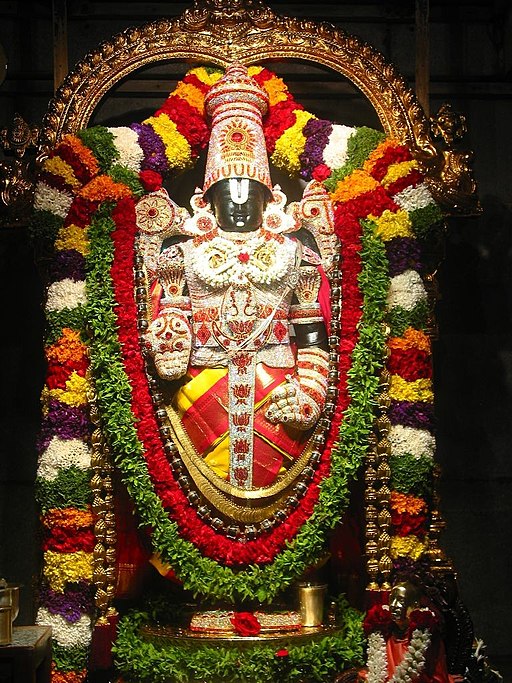
According to the Srimad Bhagavatam, during Satya Yuga, Hiranyaksha caused the earth to sink to the bottom of the Garbhodaka Ocean through his exploitative actions. The devatas approached Lord Brahma, who prayed to Lord Vishnu. Lord Vishnu appeared from Brahma’s nose in the form of Sri Varaha Dev and defeated Hiryanaksha, lifting the earth with his tusks and bringing her to a safe position on top of the Garbhodaka Ocean.
Bhudevi, an expansion of the goddess Laxmi and the goddess of the earth, was pleased to be reunited with her eternal consort, Sri Varaha Dev. In Vaikuntha, “Bhu-Varaha ” resides eternally, so Bhudevi requested that Lord Varahadev stay with her on the earth. Sri Varaha Dev fulfilled her desire by calling Garuda to fly to Vaikuntha and bring one of his favorite mountains down to the earth. He and Bhudevi could then reside together on that mountain, which is now known as Tirumala. The mountain was brought from Vaikuntha by Garuda himself.
Additionally, Sesa, the divine expansion of the Lord, who appears as paraphernalia to support the Lord’s pastimes. Adi sesa incarnated on earth as the seven hills on which Tirumala is situated. Therefore, the seven hills are called Seshadri. Sesa knew that the Supreme Lord would come to live on these hills and wanted to be there to participate and support his divine pastimes.
Picture attributions :
JediPro, CC BY-SA 3.0 via Wikimedia Commons
Atarax42, CC BY-SA 3.0 via Wikimedia Commons
Atarax42, CC BY-SA 3.0 via Wikimedia Commons
Dhwani Shree, CC BY-SA 4.0 via Wikimedia Commons
Shitha Valsan, CC BY-SA 4.0 via Wikimedia Commons
Atarax42, CC BY-SA 3.0 via Wikimedia Commons
Pattnaik.chandan, CC BY-SA 4.0 via Wikimedia Commons
Kashibanaras, CC BY-SA 4.0 via Wikimedia Commons
Vinayaraj, CC BY-SA 4.0 via Wikimedia Commons
Ssriram mt, CC BY-SA 4.0 via Wikimedia Commons
Writer hit, CC BY-SA 4.0 via Wikimedia Commons
Karsolene, CC BY-SA 3.0 via Wikimedia Commons